Understanding Lovebird Nutritional Needs for Optimal Health

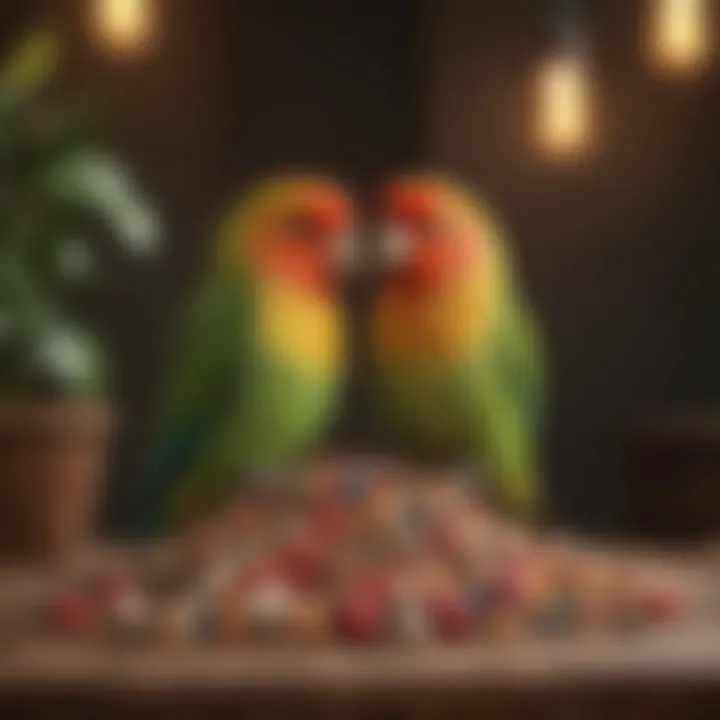
Animal Species Profile
Prelims to the Animal Species
Lovebirds are small, colorful parrots that capture the heart of many bird enthusiasts. They are part of the genus Agapornis, which literally means "birds of love," highlighting their affectionate nature. Found primarily in Africa, these birds thrive in various environments ranging from savannas to woodlands. Their social behavior and engaging personalities make them popular pets across the globe.
Physical Characteristics and Appearance
Lovebirds are known for their vibrant plumage and charming features. Typically, they are small in size, averaging about 5 to 6 inches in length. Their coloration varies depending on the species; common hues include bright greens, yellows, and blues. Unique facial markings also characterize different types of lovebirds, such as the peach-faced lovebird, which features a striking peach-colored face and breast.
Natural Habitat and Distribution
In the wild, lovebirds inhabit regions in Africa, particularly in countries like Angola, Kenya, and Tanzania. They are often found in flocks, building nests in tree cavities. Lovebirds prefer areas with ample food sources and places to play. Their adaptability allows them to thrive in both tropical and subtropical climates.
Behavior and Social Interactions
Lovebirds are highly social creatures. They thrive on interaction with their peers, often engaging in playful activities and forming strong bonds with their companions. Their communication is rich, utilizing a variety of chirps and whistles to express different emotions or to signal their needs. Understanding their social dynamics is essential for fostering a healthy environment for pet lovebirds.
Nutritional Needs of Lovebirds
Importance of a Balanced Diet
A balanced diet is crucial for lovebirds to support their overall health. They require a mix of seeds, fruits, vegetables, and sometimes commercial feeds to meet their nutritional needs. Proper nutrition helps prevent obesity, nutritional deficiencies, and health conditions that may arise from poor diet.
Key Components of Lovebird Diets
- Seeds: Primary component, but should not be the sole food source. A variety of seeds ensures adequate nutrition.
- Fruits: Fresh fruits such as apples, bananas, and berries provide essential vitamins.
- Vegetables: Leafy greens, carrots, and peppers introduce important minerals.
- Commercial Feeds: Look for high-quality pellets that are specifically formulated for lovebirds, ensuring they receive balanced nutrition.
Common Misconceptions about Lovebird Diets
Many pet owners may mistakenly believe that lovebirds can thrive solely on seeds. In reality, this limited diet can lead to serious health issues. Understanding the full spectrum of their dietary needs is crucial to their longevity and quality of life.
Tips for Optimal Nutrition
- Fresh Water: Always provide fresh and clean water to keep them hydrated.
- Variety: Regularly rotate different food items to keep the diet engaging.
- Introduce New Foods Gradually: This helps prevent digestive issues and encourages new eating habits.
A well-balanced diet supports the happiness and health of lovebirds.
Ending
Preamble to Lovebird Diet
The diet of lovebirds is an essential aspect of their overall health and well-being. Proper nutrition goes beyond just filling a bowl with seeds. Understanding what these birds need can help pet owners prevent health issues and ensure vibrant, happy pets. Lovebirds, as small parrots, have unique dietary requirements that deserve careful consideration. This section will explore those requirements and how they relate to the bird's natural behaviors and preferences.
Understanding Lovebird Preferences
Lovebirds are naturally curious and social creatures. Their preferred food consists not just of seeds, but a variety of fruits, vegetables, and nuts as well. A diverse diet mimics their natural feeding habits, which are essential for proper nutrient absorption. By knowing what lovebirds enjoy, owners can create a more inviting and engaging feeding experience. Foods such as millet, apple, and spinach are often favored choices. Additionally, observing their reactions to various foods can inform what to include in their daily regimen.
Natural Habitat and Feeding Behavior
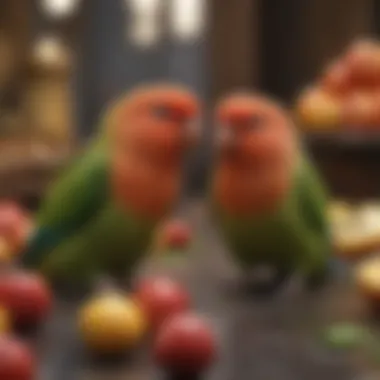
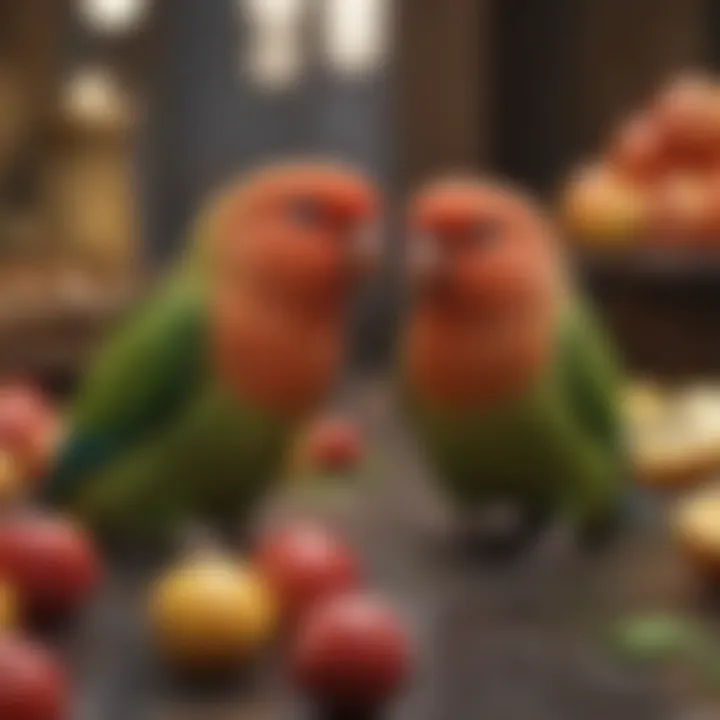
In the wild, lovebirds inhabit regions of Africa that offer a rich diversity of food sources. Their feeding behavior includes foraging, a crucial activity that helps maintain their mental and physical health. In this process, they naturally select a range of items like seeds, fruits, and buds.
This behavior indicates that lovebirds benefit from varied diets. It withholds them from dietary boredom and can prevent nutritional deficiencies over time. To provide a balanced diet tailored to their needs, owners should strive to replicate this diversity in a controlled environment. Attention to their natural habitat allows for better diet structuring, ensuring lovebirds receive adequate vitamins and minerals for optimal health.
Core Components of a Lovebird Diet
Understanding the core components of a lovebird diet is essential for ensuring their health and well-being. A well-balanced diet is fundamental in promoting not only their physical health but also their emotional well-being. Lovebirds, being small and vibrant, require a diverse range of nutrients that should come from multiple food sources. The key components typically included are seeds, fruits, vegetables, and commercial pellets. Each of these elements plays a significant role in providing the necessary vitamins and minerals vital for the longevity and happiness of lovebirds.
Seeds
Seed Types
Seeds form the foundational component of a lovebird's diet. There are several types of seeds available, and they are usually categorized by their nutrient profiles. Popular seed types for lovebirds include millet, canary seed, and safflower seed. Each type has its unique benefits. For example, millet is generally well-liked by lovebirds and provides a good source of carbohydrates. Canary seed contributes less fat and is often better for maintaining a healthy weight. The right combination of these seeds can ensure a balanced intake of essential fatty acids and proteins.
Nutritional Benefits
The nutritional benefits of seeds cannot be understated. Seeds are rich in fats, proteins, and essential fatty acids, which are critical for energy levels and overall body function. For lovebirds, a diet that includes seeds can also help in feather growth and maintenance. Seeds also provide a variety of vitamins, particularly the B-vitamins, which support various bodily functions including metabolism and immune response. However, it is essential that seeds do not dominate their diet, as this can lead to an unbalanced nutrient intake.
Potential Downsides
While seeds have many benefits, they also have potential downsides. One of the main issues is their high-fat content. If lovebirds consume too much seed, they may face obesity, which can lead to several health problems. Additionally, reliance on seeds alone can result in nutritional deficiencies, particularly in vitamins and minerals not readily found in seeds. Therefore, it is important to integrate a variety of food types into their diet, rather than focusing solely on seeds.
Fruits
Recommended Varieties
Fruits serve as another crucial component in a lovebird's diet. Recommended varieties include apple, banana, and berries. These fruits are not only appealing to lovebirds, but they also contain valuable nutrients. Apples provide fiber and antioxidants, while bananas offer potassium, essential for muscle function. It is important to introduce fruits gradually to ensure that lovebirds accept them well and to monitor any digestive issues.
Serving Suggestions
Serving fruits in a fun and varied way can enhance a lovebird's eating experience. One method is to chop the fruits into small, bite-sized pieces to encourage them to forage. Additionally, once in a while, you can hang halved fruits like oranges in their cage. This mimics their natural foraging behavior and engages them mentally. However, fruits should be offered in moderation, as the high sugar content can lead to health issues if overconsumed.
Health Benefits
Fruits provide numerous health benefits. They are rich in vitamins, particularly vitamin C, which can boost the immune system, and fiber that aids digestion. These elements are key to maintaining optimal health and preventing disorders commonly associated with inadequate diets. Including fruits can also add variety to their diet, which is psychologically beneficial for lovebirds.
Vegetables
Best Choices
A variety of vegetables can also enrich a lovebird's diet. Some of the best choices are leafy greens like kale, spinach, and broccoli. These veggies are essential sources of vitamins A, C, and K, contributing to many bodily functions. Introducing vegetables can be tricky; not all lovebirds accept them readily. As a result, patience is needed when presenting new options.
Preparation Methods
When serving vegetables, preparation matters a lot. They should be washed thoroughly to remove any pesticides and cut into manageable pieces. Steaming some veggies can make them more appealing, while others may be fed raw. It helps keep the nutrients intact. Mixing vegetables together in a small dish can create a colorful and visually appealing meal that attracts lovebirds.
Daily Intake Recommendations
For a well-rounded diet, daily intake of vegetables should be encouraged. A good guideline is to offer vegetables as a supplement to seeds and fruits, making up about 20-30% of their total food intake. This balance ensures that lovebirds receive a wide range of nutrients crucial for health without overwhelming them with any one type of food.
Commercial Pellets
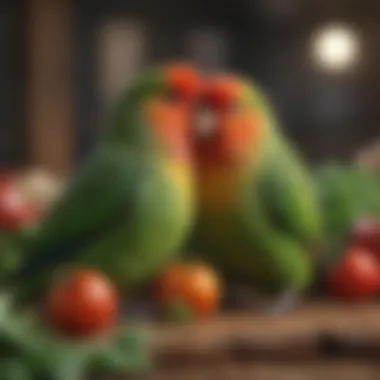
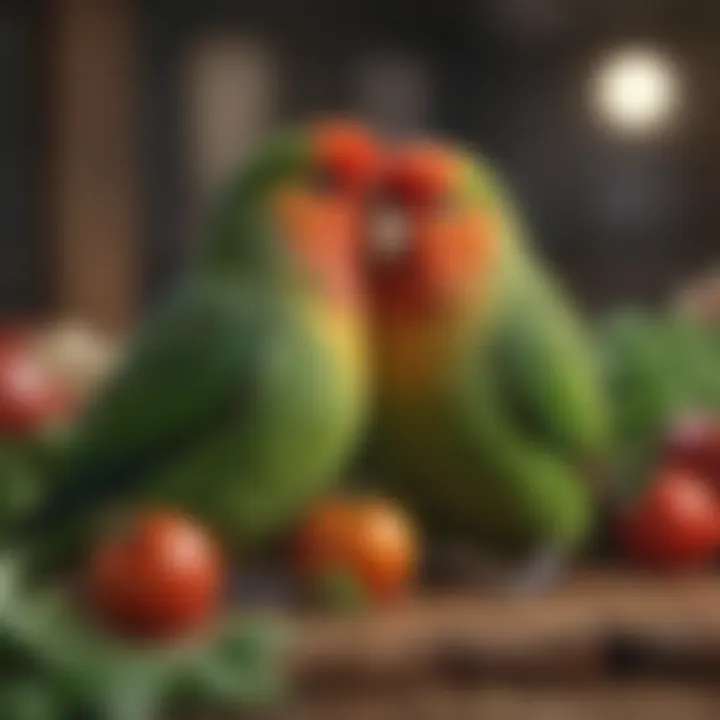
Choosing High-Quality Pellets
Commercial pellets can provide a balanced alternative or supplement to a natural diet. When choosing high-quality pellets, it is essential to select brands that use natural ingredients and avoid artificial colors or preservatives. Pellets made specifically for lovebirds are advisable, as they are formulated to meet their specific nutritional needs. This can be an efficient way to ensure that lovebirds receive a consistent supply of essential nutrients.
Benefits of Pellets
The primary benefit of pellets is that they are designed to be nutritionally complete. This reduces the risk of deficiencies from an imbalanced diet. Pellets can also minimize waste, as they are more dense in nutrients than seed mixes and less prone to being picked through. Some pellets contain added probiotics which can further benefit a lovebird's digestive health.
Supplementing Natural Foods
Supplementing natural foods with commercial pellets offers a balanced approach to lovebird nutrition. While pellets provide essential nutrients, they should not replace natural foods completely. A blend of pellets along with seeds, fruits, and vegetables allows for a varied diet that meets their dietary needs. This method can help maintain overall health while also satisfying their natural foraging instincts.
A well-balanced diet incorporating seeds, fruits, vegetables, and high-quality pellets is vital for the health of lovebirds.
Importance of Variety in Diet
A balanced diet for lovebirds goes beyond simply feeding seeds. Importance of variety in diet is crucial for their health. Lovebirds, like many other species, need a diverse array of nutrients that come from different food sources. This way, they do not lack vital vitamins and minerals.
Preventing Nutritional Deficiencies
Nutritional deficiencies can lead to a range of health issues in lovebirds. If they eat a monotonous diet, they may not receive essential nutrients required for their growth and vitality. For instance, Vitamin A is necessary for reproductive health and eyesight. If lovebirds lack this vitamin, they may develop issues like feather plucking or even vision problems. It is also key in maintaining a strong immune system. Moreover, calcium is vital for bone health and muscle function. A varied diet can help prevent these deficiencies. Including different foods, like vegetables and fruits, ensures that lovebirds get a wide spectrum of nutrients.
Encouraging Natural Foraging Behavior
Lovebirds are naturally inclined to forage for food in their habitat. This instinct can be implemented in their captive environment. Providing a variety of foods encourages lovebirds to explore their surroundings. It stimulates their natural behavior and keeps them engaged. Allowing lovebirds to choose their food can mirror their wild experience more closely. This can lead to better mental health as well. Additionally, introducing new food items regularly can reduce boredom and stress. Lovebirds are active and intelligent birds requiring stimulation through both physical and mental avenues. Varied diets play a significant role in fulfilling these needs.
The right variety in diet can support both mental and physical well-being for lovebirds.
In summary, focusing on a diverse diet for lovebirds is not just about aesthetic appeal. It's a solid foundation for their health and happiness. By ensuring a mix of seeds, fruits, and vegetables, you can optimize their nutrition. This approach provides essential nutrients while catering to their instinctual behaviors.
Common Misconceptions About Lovebird Nutrition
Overreliance on Seeds
One prevalent myth is that lovebirds can thrive on seeds alone. While seeds are indeed a staple in their diet, they should not be the only food source. Seeds often lack essential vitamins and minerals that lovebirds require for optimal health. Relying too much on seeds can lead to nutritional imbalances. Many pet owners may think that seeds are all their birds need because lovebirds love them. However, this approach neglects the importance of diversity in their diet.
Seeds are high in fat, which can lead to obesity if consumed in excess. An overabundance of fatty seeds, like sunflower seeds, can also contribute to liver disease and other health issues. For a well-rounded diet, it is important to include fruits, vegetables, and high-quality pellets alongside seeds. According to veterinarians specialized in avian care, a mix of foods not only satisfies lovebirds' taste preferences but also provides comprehensive nutrition.
Myths About Fruits and Vegetables
Another misconception is that fruits and vegetables are not suitable for lovebirds. Some owners believe that feeding these foods might lead to digestive issues. This notion is fundamentally flawed. In fact, fresh produce provides essential nutrients that seeds often lack. Fruits like apples, bananas, and berries, as well as a variety of vegetables, contain vitamins that support the immune system and overall health.
It is critical to offer a range of these foods to ensure a balanced intake of nutrients. Lovebirds might be hesitant at first to try new foods, but with time and encouragement, they usually accept fruits and vegetables. Importantly, these foods can also help in keeping their beaks healthy and their digestive systems functioning well.
"A diverse diet is essential not just for physical health but also for the behavioral enrichment of lovebirds."
Potential Health Risks of Poor Nutrition
A poor diet can lead to several health problems in lovebirds. Understanding these risks is crucial for any owner who wishes to keep their pet healthy and vibrant. Without the right nutrients, lovebirds can suffer from both immediate and long-lasting health issues. Regular monitoring of their dietary intake ensures they receive all the essential elements of a balanced diet, reducing the chances of potential health problems.
Obesity and Related Issues


Obesity is a prevalent issue among lovebirds that arises primarily from improper feeding practices. Over-reliance on high-fat seeds or an excessive intake of pellets can lead to weight gain. This condition not only affects mobility but also impacts their overall well-being. Obese lovebirds are more susceptible to diseases, such as heart problems and diabetes.
Maintaining a healthy weight is vital. To prevent obesity, owners should consider the following:
- Regular exercise: Providing ample opportunity for flying and play.
- Portion control: Regulating the amount of food offered daily.
- Balanced meals: Including a mix of seeds, fruits, and vegetables in their diet.
Nutritional Deficiencies
Nutritional deficiencies occur when lovebirds do not receive essential nutrients necessary for their health. These can have dire effects on various bodily functions, leading to overall weakness and illness. Attention to these deficiencies is vital for preventing disease and supporting a healthy life.
Symptoms to Watch For
When lovebirds experience nutritional deficiencies, certain symptoms may manifest. Common signs include:
- Lack of energy: Birds may become lethargic.
- Feather deterioration: Poor plumage can indicate nutritional gaps.
- Change in appetite: Skipping meals or showing limited interest in food.
Identifying these symptoms early can help in addressing malnutrition before it escalates. Proper feeding habits can mitigate these issues, allowing lovebirds to thrive in their environment.
Long-Term Consequences
The long-term consequences of neglecting a proper diet can be profound. Over time, poor nutrition can lead to serious health complications. Potential outcomes include:
- Organ failure: Vital organs may become overstressed or weakened.
- Reproductive issues: Breeding health may decline with nutritional deficits.
- Decreased lifespan: Overall longevity can be adversely affected due to chronic health problems.
Being informed about the potential consequences of inadequate nutrition allows caretakers to make better choices. Ensuring lovebirds receive a diet rich in the right nutrients is essential for a healthy, vibrant life.
Practical Tips for Feeding Lovebirds
Feeding lovebirds can seem straightforward, yet it requires careful consideration of their nutritional needs. Crafting practical tips for feeding lovebirds helps pet owners provide a balanced diet. This is crucial not only for promoting health but also for enhancing their overall well-being. A well-fed lovebird displays a lively demeanor and vibrant plumage. When you understand the essential guidelines for feeding them, you create a thriving environment for these delightful creatures.
Creating a Balanced Meal Plan
A balanced meal plan is vital for the well-being of lovebirds. It encompasses various foods that offer essential nutrients. Here are some key components to consider:
- Variety: Ensure that the diet includes seeds, fruits, vegetables, and commercial pellets. Each group provides specific nutrients.
- Portion Control: Measure the food quantity to prevent overfeeding. Adjust the serving size based on their age, size, and activity level.
- Freshness: Always use fresh fruits and vegetables. They should be washed and cut in appropriate sizes. Spoiled food can cause health problems.
- Supplements: Occasionally introduce supplements such as vitamins. Consult a veterinarian for guidance on appropriate options.
Creating a balanced meal plan is about understanding lovebird preferences and nutritional requirements to promote optimal health.
Monitoring Feeding Habits
Observing lovebird feeding habits is essential for assessing their health. Consistent monitoring can help identify issues early. Key points include:
- Behavioral Changes: Note any changes in their eagerness to eat. A drop in appetite can indicate health issues.
- Diet Quality: Ensure that the lovebird is eating a variety of foods. They should not only consume seeds but also fruits and vegetables.
- Waste Management: Monitor how much of the food is wasted. Excessive leftovers can suggest that the food is not suitable or fresh.
- Weight Tracking: Regularly weigh your lovebird to ensure it maintains a healthy weight. Sudden changes can signify underlying problems.
By understanding and implementing these practical feeding tips, you can help ensure that your lovebirds remain healthy and happy, thriving in an environment tailored to their dietary needs.
The End
The conclusion of this article emphasizes the significance of understanding lovebird dietary needs. A balanced diet is essential for their overall health and well-being. The various food sources, such as seeds, fruits, and vegetables, are not just treats but play critical roles in their nutrition. Each lovebird is unique, and their needs can vary based on factors like age, activity level, and health status. Thus, tailored feeding strategies are vital.
Summarizing Lovebird Dietary Needs
In summarizing the dietary needs of lovebirds, it is crucial to highlight the core components that should constitute their diet. Lovebirds thrive on a varied intake. Seeds provide essential fatty acids and protein, but they should not form the entire diet. Fruits and vegetables add important vitamins, minerals, and water content. Additionally, high-quality commercial pellets can supplement their diet well. Each food group contributes unique nutritional values, and it's essential to balance these for optimal health. The ultimate goal is to ensure lovebirds receive the full spectrum of nutrients crucial for their vitality. Regular rotation of food types keeps their diet interesting and aligns with their natural foraging instincts.
Final Thoughts on Nutrition
Addressing the proper nutritional approach for lovebirds encapsulates a broader understanding of pet husbandry. Careful attention to their dietary needs not only supports their physical health but fosters their psychological well-being. Misconceptions, such as the belief that seeds alone suffice, must be corrected as they lead to various health issues, such as obesity and deficiencies. By fostering a diverse and balanced feeding routine, lovebird owners can enjoy the rewards of their birds’ long, healthy lives. Remember, every lovebird deserves a diet that reflects their natural behaviors and nutritional requirements. For further information on avian diets and health, resources like Wikipedia and Britannica can be quite helpful.







